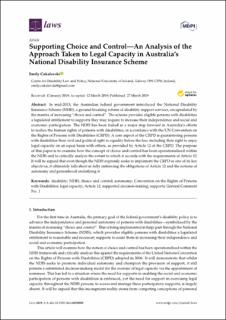Supporting Choice and Control—An Analysis of the Approach Taken to Legal Capacity in Australia’s National Disability Insurance Scheme
Journal article

Åpne
Permanent lenke
https://hdl.handle.net/11250/3062197Utgivelsesdato
2019Metadata
Vis full innførselSamlinger
Originalversjon
Cukalevski, E. (2019). Supporting Choice and Control—An Analysis of the Approach Taken to Legal Capacity in Australia’s National Disability Insurance Scheme. Laws, 8(8). https://doi.org/10.3390/laws8020008Sammendrag
In mid-2013, the Australian federal government introduced the National Disability Insurance Scheme (NDIS), a ground-breaking reform of disability support services, encapsulated by the mantra of increasing “choice and control”. The scheme provides eligible persons with disabilities a legislated entitlement to supports they may require to increase their independence and social and economic participation. The NDIS has been hailed as a major step forward in Australia’s efforts to realize the human rights of persons with disabilities, in accordance with the UN Convention on the Rights of Persons with Disabilities (CRPD). A core aspect of the CRPD is guaranteeing persons with disabilities their civil and political right to equality before the law, including their right to enjoy legal capacity on an equal basis with others, as provided by Article 12 of the CRPD. The purpose of this paper is to examine how the concept of choice and control has been operationalized within the NDIS and to critically analyze the extent to which it accords with the requirements of Article 12. It will be argued that even though the NDIS expressly seeks to implement the CRPD as one of its key objectives, it ultimately falls short in fully embracing the obligations of Article 12 and the notions of autonomy and personhood underlying it.
